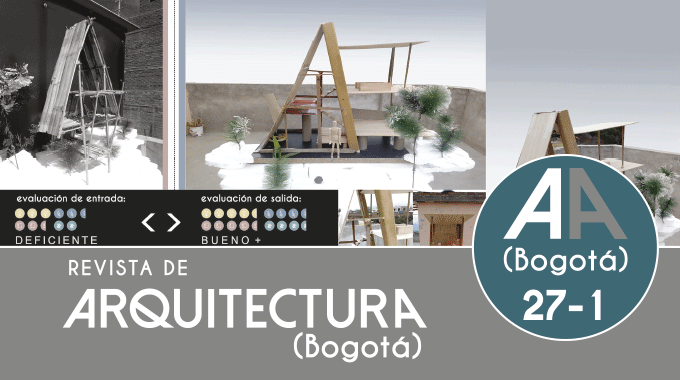

This work is licensed under a Creative Commons Attribution-NonCommercial 4.0 International License.
Revista de Arquitectura is an open access journal. More information...
Authors retain copyright and grant to the Revista de Arquitectura the right of first publication, which will be simultaneously subject to the Creative Commons (CC) BY-NC license.
Authors will sign a non-exclusive distribution license for the published version of the article by completing (RevArq FP03 Permission to Reproduce).
Self-archiving will comply with SHERPA/RoMEO guidelines and the Green classification.
To see in detail these guidelines, please consult...
Abstract
At the beginning of the architect's training, we generally rehearse with various exercises of pure empirics with logical arguments and decision-making process of the experience of each teacher that replicates as a model to follow in the students. The purpose is that each student, through the decisionv making learning of the didactic strategy, assumes their own processes to solve their architectural project. The design research was quasi-experimental, with a sample of eighteen students from project workshop 1, where the before and after of three project essays corresponding to each study unit, evaluated with the analytical rubric, were examined. The structured system of pre-projective and projective decision making of the architectural project in the initial training led to a significant improvement in learning, with a growth of 45 % compared to the beginning of the study. In addition, significant improvement was observed in the dimensions of artistic sense, design sense, plastic imagination and constructive sense. The results reveal that the students were able to show an upward trend of 25 % in the final scores of each unit, the implementation of the didactic strategy was shown as a relevant factor in the initial training of the architect, promoting the development of decision-making skills and contributing to the autonomous knowledge of the students.

References
Alba Dorado, M. (2018). Estrategias formativas en la iniciación del aprendizaje del proyecto arquitectónico. ESTOA, 7(14), 17-29. https://doi.org/10.18537/est.v007.n014.a01
Aranguren, J. (2017). Los recursos naturales en la expresión plástica: Estrategia didáctica en la formación de ingenieros. En O. Abreu, J. Jácome, M. Gallegos, & G. Arciniegas (Comps.), Didáctica integradora de la educación superior (pp. 165-178). Universidad Técnica del Norte.
Castaño, J., Bernal, M., Cardona, D., & Ramírez, I. (2005). La enseñanza de la arquitectura. Revista Latinoamericana de Estudios, 1(1), 125-147. https://www.redalyc.org/pdf/1341/134116845008.pdf
Gallego Jorreto, M. (2018). Sobre la enseñanza de la arquitectura. P+C, proyecto y ciudad. Revista de temas de arquitectura, 9, 121-130. https://repositorio.upct.es/entities/publication/e5af8f59-ed-56-4a83-8d63-78bb500dc075
Gombrich, E. H. (1980). El sentido del orden. Estudio sobre la psicología de las artes decorativas. Gustavo Gili.
Inda Caro, M., Álvarez González, S., & Álvarez Rubio, R. (2008). Métodos de evaluación en la enseñanza superior. Revista de Investigación Educativa, 26(2), 539-552. https://revistas.um.es/rie/article/view/94061
Linder, P. (1959). Examen vocacional para estudiantes de arquitectura. Experiencias adquiridas. Facultad de Arquitectura, Universidad Nacional de Ingeniería.
Manrique, H., & Castro Correa, A. (2019). Toma de decisiones: intuición y deliberación en la experiencia de los decisores. Innovar, 29(73), 149-164. https://doi.org/10.15446/innovar.v29n73.78028
Martinez Vitor, C. F. (2021). Rúbrica para evaluar el proyecto de arquitectura en el taller de diseño. Arquitek, 18, 48-64. https://doi.org/10.47796/ra.2020i18.438
Moneo, R. (2017). Una manera de enseñar arquitectura: lecciones desde Barcelona 1971-1976.Universitat Politècnica de Catalunya. Iniciativa Digital Politècnica.
Moreno Bote, R. (2018). ¿Cómo tomamos decisiones? Los mecanismos neuronales de la elección.Bonalletra Alcompas.
Palacios Mendizábal, G. A. (2005). Audacia y convicción. Apriorística de las ideas geométricas.Colegio de Arquitectos del Perú. Regional Junín.
Ratcliff, R., Smith, P., Brown, S., & McKoon, G. (2016). Diffusion decision model: Current issues and history. Trends in Cognitive Sciences, 20(4), 260-281. http://dx.doi.org/10.1016/j.tics.2016.01.007
Rendón Jaluff, I. A. (2019). Estrategias didácticas de la enseñanza aprendizaje de la asignatura proyecto arquitectónico [Maestría en Educación Superior]. Universidad Católica de Santiago de Guayaquil. http://repositorio.ucsg.edu.ec/handle/3317/14081
Rendón Jaluff, M. I. A., Reyes Pincay, M. B. L., & Torres Ruilova, M. B. O. (2018). Proceso de enseñanza aprendizaje del proyecto arquitectónico. Revista Conrado, 14(63), 30–34. http://scielo.sld.cu/scielo.php?script=sci_arttext&pid=S1990-86442018000300030
Rodríguez de Torres, R. (2019). Poiesis somática. El proyecto como teatro de las decisiones del arquitecto. Diseño Editorial.
Santa María, C. (2019). Enfoque teórico práctico y percepción del desempeño docente en la enseñanza del proyecto arquitectónico en la UNCP-2017 [Tesis de maestría]. Universidad Nacional del Centro del Perú, Huancayo.
Sarquis, J. (2007). Itinerarios del proyecto. La investigación proyectual como forma de conocimiento en arquitectura. Nobuko.
Vargas, J., & Giraldo, J. (2015). Modelo didáctico en toma de decisiones relacionadas con la gestión de producción y operaciones. Aplicación en ingeniería química. Formación Universitaria, 8(6), 85-94. https://www.redalyc.org/pdf/3735/373544193011.pdf
Wu, T., & Wu, Y. (2020). Applying project-based learning and SCAMPER teaching strategies in engineering education to explore the influence of creativity on cognition, personal motivation, and personality traits. Thinking Skills and Creativity, 35. https://doi.org/10.1016/j.tsc.2020.100631
































